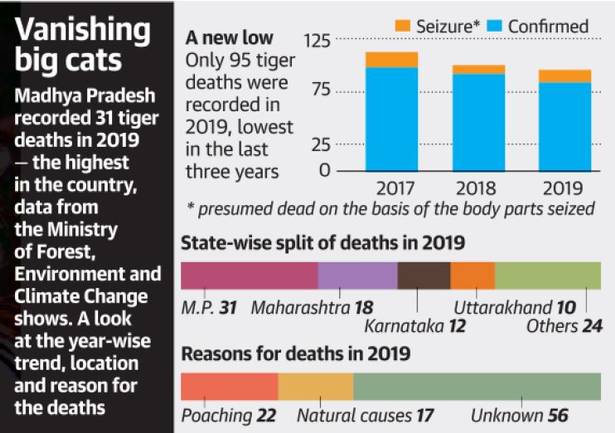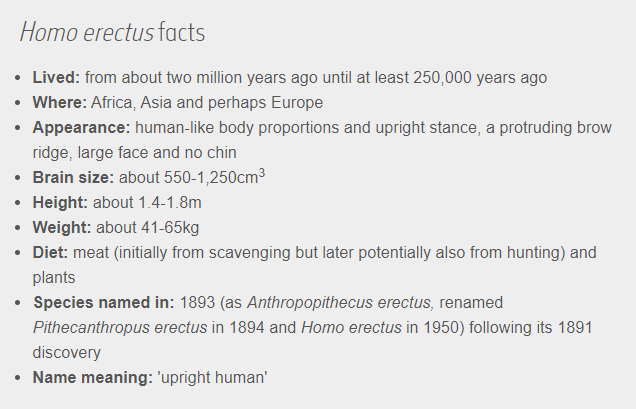New Norms For Reward To Whistleblowers
Why in News
The Securities and Exchange Board of India (SEBI) has come out with a new mechanism to reward whistle-blowers and other informants for sharing information about insider trading cases.
Key Points
- It would be mandatory to disclose the source of information. At the same time, confidentiality regarding the identity of the informant would be protected.
- Reward would be given in case the information provided leads to a disgorgement of at least ₹1 crore in accordance with the “Prohibition of Insider Trading (PIT) Regulations”.
- Disgorgement is repayment of ill-gotten gains that is imposed on wrongdoers by the courts. This implies that funds that were received through illegal or unethical business transactions are disgorged, or paid back, with interest to those affected by the action.
- The Office of Informant Protection (OIP) has been established by the SEBI as an independent office for receiving and processing the Voluntarily Information Disclosure Form. The OIP would serve as a medium of exchange between the informant or legal representative and the SEBI.
- An informant would have to voluntarily submit original information pertaining to any violation of insider trading laws to the OIP, through a VID form. He has to reveal his identity at the time of submission of the VID form.
- In case, the information is submitted through a legal representative, the identity of the informant is not required to be revealed at the time of submission of VID form. However, the identity of the informant would be required to be revealed prior to payment of reward, if any.
Note
- Insider Trading
- It is the act of trading, directly or indirectly, in the securities of a publicly listed company by any person, who may or may not be managing the affairs of such company, based on certain information, not available to the public at large, that can influence the market price of the securities of such company.
- SEBI through SEBI (Prohibition of Insider Trading) Regulations, 2015 and by making amendments to the Regulations and issuance of Circulars from time to time, regulates Insider Trading.
- According to PIT Regulations, it is prohibited to pass Unpublished Price Sensitive Information (UPSI) for a purpose other than legitimate purposes.
- Whistleblowing
- According to the Companies Act, 2013, whistleblowing is an action aimed at drawing the attention of stakeholders to instances of unethical practices in an organization.
- A whistleblower can be anyone who chooses to expose wrong practices and has evidence to support the allegations. They can be either from within or outside the organization—such as current and former employees, shareholders, external auditors, and lawyers.
- In India, whistleblowers are protected by the WhistleBlowers Protection Act, 2014. The law provides for the protection of their identity and also has strict norms to prevent their victimization.
North-East Monsoon Ends with 30% Surplus Rain
Why in News
India witnessed a 30% surplus in total rainfall during the Northeast monsoon in 2019.
- October to December is recognised as the period for Northeast monsoon by the India Meteorological Department (IMD).
Key Points
- In 2019, the Southwest monsoon withdrew late so there was a delay for the onset of the northeast monsoon. Despite this, southern peninsula received normal or above-normal rainfall during the three months.
- Rainfall during these three months was evenly distributed, both spatially and temporally, with every week recording normal rainfall throughout the season.
- 2019 witnessed the rare meteorological coincidence of the northeast monsoon making its onset on the same day as the southwest monsoon withdrew officially.
Two Monsoons of India
- The south-west monsoon (summer monsoon) blows from sea to land after crossing the Indian Ocean, Arabian Sea, and the Bay of Bengal.
- It brings most of the rainfall in the country, approximately 75% of India’s annual rainfall.
- It gets its name from the direction in which it travels, from the southwest to the northeast.
- The northeast monsoon (winter monsoon) blows from land to sea.
- During this period, rainfall is experienced over southern states, mainly Tamil Nadu, Kerala, Andhra Pradesh along with some parts of Telangana and Karnataka.
- In areas around Jammu and Kashmir, Himachal Pradesh, Uttarakhand and along the northeast, precipitation during this period reported is either in the form of rainfall or snowfall.
- It can be noted that many other parts of the country, like the Gangetic plains and northern states, also receive rain in November and December but this is not due to the northeast monsoon.
- It is caused mainly by the Western Disturbances, an eastward-moving rain-bearing wind system that originates beyond Afghanistan and Iran, picking up moisture from as far as the Mediterranean Sea, even the Atlantic Ocean. In the higher reaches of Jammu and Kashmir, Himachal Pradesh, and Uttarakhand, the precipitation is often in the form of snow.
- The northeast monsoon does not have anything to do with northeast India. It derives its name from the direction in which it travels, from the northeast to the southwest.
India Meteorological Department
- It was established in 1875.
- It is an agency of the Ministry of Earth Sciences of the Government of India.
- It is the principal agency responsible for meteorological observations, weather forecasting and seismology.
Reduced Tiger Mortality in 3 Years
Why in News
According to the Ministry of Forest Environment and Climate Change (MoEFCC), the number of tiger deaths in 2019 has decreased for the first time in three years.
- The number of tiger deaths recorded in previous years are 122 (2016), 115 (2017), 100 (2018) and 95 (2019).
- Decreasing tiger mortality has emerged parallelly with the increasing numbers of tigers in the country.
- The tiger census report (2019), reported an increase in the number of tigers compared to 2014.
Key Points
- Numerics:
- For 2019, 84 cases of tiger deaths and 11 cases of seizures (a tiger is presumed dead on the basis of body parts seized by authorities) are reported in the country.
- Madhya Pradesh, which has the highest number of tigers in the country (526, as per the last census), has recorded the highest number of tiger deaths (31) followed by Maharashtra (18), Karnataka (12) and Uttarakhand (10).
- Deaths were also recorded from non-tiger bearing states like Gujarat, where a tiger had strayed into the State and died.
- Reason:
- Poaching is the main reason for tiger deaths in the country followed by other natural reasons.
- The data on tiger mortality also confirms 22 cases of poaching in the country.
- Location:
- Tigers are most vulnerable when they are outside reserves as they are not under surveillance.
- Almost over 70% of cases of poaching have been reported outside tiger reserves.
- Use of Technology:
- The reduced tiger mortalities are due to usage of technology for surveillance, good management of tiger reserves and a lot of awareness and education programmes on tiger conservation.
- M-STrIPES (Monitoring System for Tigers-Intensive Protection & Ecological Status) patrolling app is deployed and used in every tiger reserve.
- The reduced tiger mortalities are due to usage of technology for surveillance, good management of tiger reserves and a lot of awareness and education programmes on tiger conservation.
Homo erectus
Why in News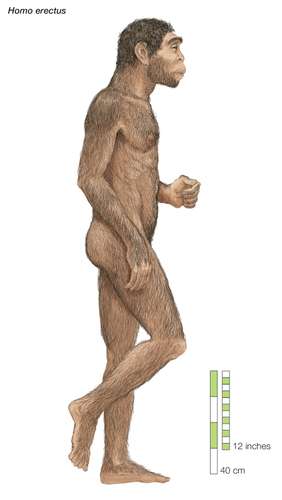
According to a study published in ‘Nature’, the last known settlement of Homo erectus was situated in Ngandong on the Indonesian island of Java.
- Homo erectus (meaning upright man) is an extinct species of the human genus (Homo), perhaps an ancestor of modern humans (Homo sapiens).
- As per the study, the human ancestors existed on the Indonesian island between 1,08,000 and 1,17,000 years ago.
- While fossil remains from H. erectus are found in Africa, like those of earlier hominins, they have also been identified at fossil sites widely dispersed across Eurasia.
- In particular, H. erectus had a similar range of body sizes to modern humans, and it is the first human ancestor to have similar limb and torso proportions to those seen in modern humans. This suggests it had adapted to walking on two feet in a more open, grassland environment, rather than swinging from tree branch to branch.
Hominin
- Hominin is any member of the zoological “tribe” Hominini (family Hominidae, order Primates), of which only one species exists today—Homo sapiens, or human beings.
- The term is used most often to refer to extinct members of the human lineage, some of which are now quite well known from fossil remains: Homo neanderthalensis (the Neanderthals), Homo erectus, Homo habilis, and various species of Australopithecus.
Odissi Dance
Odissi dance is one of the classical dances of India.
- It is indigenous to Orissa, eastern India, and follows the principles of the Natya-shastra.
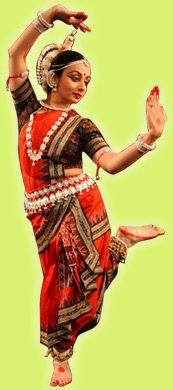
- Evolution
- The dance has its origin in the temples.
- The carvings found at the Udayagiri Monastery denote that Odissi was patronised as early as the 2nd Century BCE and the trend continued unabated until about the 16th Century AD.
- After surviving the tumultuous years from 16th century AD till independence, Odissi underwent a renaissance of sorts which helped it become the global phenomenon it is today.
- The classical music and dance form of Odisha was prefixed with “Odissi” by noted Odia poet Kabichandra Kalicharan Pattanayak, who was the centre of the cultural revival of Odisha post-independence, to retain its distinct identity.
- Dance Techniques
- Odissi dance form can be broken down to the movement of the head, bust and torso and the accompanying gestures and expressions.
- The techniques of movement are built around the two basic postures of the Chowk and the Tribhanga. The chowk is a position imitating a square - a very masculine stance with the weight of the body equally balanced. The tribhanga is a very feminine stance where the body is deflected at the neck, torso and the knees.
- Odissi dance deals largely with the love theme of Radha and Krishna.
Natyashastra
- Natyashastra, in full Bharata Natyashastra, is a detailed treatise and handbook on dramatic art that deals with all aspects of classical Sanskrit theatre.
- It is believed to have been written by the mythic Brahman sage and priest Bharata (200 BC – 200 AD).
- Its many chapters contain detailed treatments of all the diverse arts that are embodied in the classical Indian concept of the drama, including dance, music, poetics, and general aesthetics.
- It is also known as the fifth veda as it has been evolved by taking words from the Rigveda, music from the Samaveda, gestures from the Yajurveda and emotions from the Atharvaveda.
Padmanur's Yakshagana
Why in News
Recently, the Yakshagana committee hosted the 60th annual Yakshagana in the Padmanur village, Karnataka.
- The committee is officially known as the Sarvajanika Yakshagana Bayalata Samithi and was set up in 1959.
- It is a multi-faith committee consisting of Hindus, Christians and Muslims and it hosts Yakshagana every year.
Yakshagana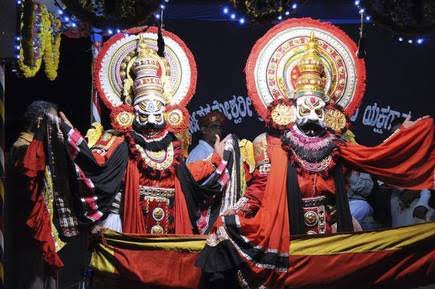
- It is a rare and unique traditional theatre of Karnataka state in India and has a recorded history of more than 5 centuries.
- It is a rich artistic blend of music, dance, speech, and costumes, this art combines the features of opera as well as drama, the characteristics of moral education and mass entertainment.
- Yakshagana is strongly influenced by the Bhakti movement.
First National Conference on Intersex Human Rights
Why in News
Recently, the first national conference on intersex human rights was organised by Srishti Madurai in partnership with Intersex Asia in New Delhi.
- The conference sought a national ban on unnecessary medical surgeries conducted on children with intersex traits and appealed to the Union government to protect their human rights.
- This demand follows Tamil Nadu’s ban on normative surgeries on infants and children, except in life-threatening situations in August 2019.
- If the ban will be adopted nationally, India will become the third country to protect the rights of intersex children after Malta and Taiwan.
Key Points
- The term intersex is often confused with transgender but the two in-fact have very different meanings.
- Transgender: Individuals who identify as transgender or transexual have a gender that is different from the one traditionally associated with the sex they were assigned at birth.
- Intersex: It refers to people born with biological or physical characteristics that are more diverse than stereotypical male or female bodies.
- The World Health Organisation (WHO) and the United Nations Human Rights Council (UNHRC) have called upon the Member States to end invasive and irreversible medical surgeries and other medical treatment on intersex children.
Srishti Madurai
- It is India’s first Genderqueer and Intersex led human rights movement and was established in September 2011 in Madurai, Tamil Nadu.
- It aims to create a space for Genderqueer, Intersex and LGBTQA+ Indians in the public discourse.
Intersex Asia
- It is an autonomous regional network of intersex-led organizations and individuals from Asian countries that work to support, educate and advocate for the rights and lives of intersex individuals and raise awareness on human rights violations and discrimination faced by intersex communities.
- It was established in February 2018 in Bangkok, Thailand.
107th Indian Science Congress
Why in News
Recently, the Prime Minister has inaugurated 107th Indian Science Congress.
- It is scheduled to take place between January 3-7, at the University of Agricultural Sciences (UAS) in Bengaluru, Karnataka.
Key Points
- The theme of the congress for 2020 is “Science & Technology: Rural Development”.
- Indian Science Congress is a major focal point for scientists, researchers and academicians interested in various aspects of scientific discoveries and technologies.
- The previous (2019) session 106th edition was held at Lovely Professional University (LPU) in Jalandhar, Punjab.
Indian Science Congress
- The Indian Science Congress Association (ISCA) owes its origin to the foresight and initiative of two British Chemists, namely, Professor J. L. Simonsen and Professor P.S. MacMahon.
- The first meeting of the Congress was held from January 15-17, 1914 at the premises of the Asiatic Society, Calcutta.
Young Scientists Laboratories
Why in News
Recently, the Prime Minister has launched 5 Young Scientists Laboratories of Defence Research and Development Organisation (DRDO).
- DRDO Young Scientist Laboratories (DYSLs) are located in five cities viz, Bengaluru, Mumbai, Chennai, Kolkata and Hyderabad.
- DRDO already has 52 labs.
- Each lab will work on key advanced technology of importance to the development of futuristic defence systems viz, Artificial intelligence, Quantum technologies, Cognitive technologies, Asymmetric technologies and Smart materials.
- It can be noted that N Chandrasekaran Committee was constituted by the Ministry of Defence in 2018 to study the use and application of artificial intelligence (AI) in the military.
- It aims to empower the youth by giving them decision making powers and challenging research opportunities.

